|
|
 |
|
Calanoida ( Order ) |
|
|
|
Diaptomoidea ( Superfamily ) |
|
|
|
Pseudodiaptomidae ( Family ) |
|
|
|
Pseudodiaptomus ( Genus ) |
|
|
| |
Pseudodiaptomus binghami Sewell, 1912 (F,M) | |
| | | | | | | Syn.: | Schmackeria binghami : Marsh, 1933 (p.43, figs.F,M);
non Pseudodiaptomus binghami malayus Wellershaus, 1969 (p.262, figs.FM) | | | | Ref.: | | | Sewell, 1912 (figs.F, Descr.F); 1919 (p.7, Rem.F,M); 1924 (p.786, fig.M, Rem.); 1932 (p.240); 1948 (p.367); Silas, 1972 (p.648); Pillai, 1976 (1980) (p.251, figs.F,M); Pillai, 1976 (1980) (p.251, figs.F,M); Ranga Reddy & Radhakrishna, 1982 (p.256, Redescr.F,M, figs.F,M); Dussart & Defaye, 1983 (p.31); Sarkar & al., 1986 (p.178); Walter, 1986 (p.132); 1986 a (p.503); 1987 (p.367); Mitra & al., 1990 (fig.3); Walter, 1994 (p.126, figs.F,M); Ramaiah al., 1996 (p.3); Ferrari & Dahms, 2007 (p.22, Rem. N); Santu K.S. & al., 2017 (p.5, figs.F, M, Rem.: genetic analysis) |  Issued from : R.B.S. Sewell in Rec. Indian Mus., 1912, 7. [Pl.XVII, Figs.8-11]. Female (from Bay of Bengal): 8, habitus (lateral left side); 9, P2; 10, P5; 11, caudal ramus. Nota: - Head and 1st thoracic segment fused, 4th and 5th fused. - Posterior border of the thorax rounded and bears a small spine near the dorsal surface. - Rostrum small and bifid. - Abdomen 4-segmented; proportional lengths of urosomites and furca as 45 : 25 : 30 : 12 : 28; the 1st segment has 2 transverse rows of minute spines on its dorsal surface and a row of spines round the dorsal half of its posterior border; there is a small blunt projection on the ventral aspect, behind the genital opening. - Caudal rami symmetrical and bear 5 setae, of which the third is considerably wider than the others and is spear-shaped. - Terminal segment of the endopod of A2 with a row of sharp spines. - P5 symmetrical.
|
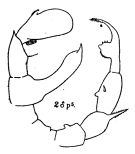 issued from : R.B.S. Sewell in Fauna of the Chilka Lake, 1924, 12. [Pl. XLV, Fig.2]. Male: P5
|
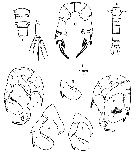 Issued from : T. C. Walter in Hydrobiologia, 1994, 292/293. [p.126, Fig.2]. Female (from Chilka Lake, India): A, urosomal somites 1-2 (dorsal); B, tip of left caudal ramus showing thickened setae; C, P5 (anterior view). Male: D, utosome (ventral); E, P5 (posterior view); F, P5 (anterior view); G, P5 of left exopodal segment 2 (posterior view); H-I, left basipod 2-exopod segment 2 variation.
|
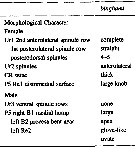 Issued from : T. C. Walter in Hydrobiologia, 1994, 292/293. [p.128, Table 2]. Morphological features of Pseudodiaptomus binghami from India and Bangladesh;
Compare with P. lobipes and P. mixtus.
|
 Issued from : T. C. Walter in Hydrobiologia, 1994, 292/293. [p.128, Table 1]. Pseudodiaptomus binghami from India: Sex, number of specimens measured, total body length range, mean total body length, mean prosome length, mean urosome length and prosome/urosome ratio of lengths. Compare with the two species in India and Bangladesh P. lobipes and mixtus.
|
 Issued from : Y. Ranga Reddy & Y. Radhakrishna in Hydrobiologia, 1982, 87. [p.258, Plate I]. Female (from 16°32'- 16°47'N; 81°4'-81°22'E): 1, habitus (dorsal with egg sacs (each with about 11 eggs); 2, same (lateral); 3, posterior part of prosome and urosome (dorsal); 4, genital area; 5, A1 and rostrum; 6, A2; 7, Md; 8, Mx1; 9, Mx2; 10 & 10a, Mxp and its modified seta; 11, P5. Nota: Proportional lengths prosome and urosome 64:36. - Head and 1st pedigerous segment fused, 4th and 5th pedigerous segments fused. - Rostrum consists of 2 filaments, short. - Posterolateral corners of prosome rounded with a dorsal spine. - Urosome 4-segmented plus caudal rami proportional lengths 31 : 15 : 21 : 9 : 22. - Genital segment symmetrical and has on the dorsal surface minute spines, arranged in 4 transverse rows; the 1st row interrupted in the middle with about 10 spines on either side; the 2nd row discontinuous laterally; the spines of these 2 rows smaller than those of the following rows; the 3rd row complete with about 8 relatively large spines on either side; the 4th row, like the first one, broken in the middle having about 6 somewhat large spines on either side. - Caudal rami symmetrical, divergent and slightly over 3 times as long as broad with hairy inner margins; each ramus with 5 unjointed setae, of which the middle one dilated and spear-shaped. In addition, a small sensory bristle lies between the 4th and 5th setae. - A1 21-segmented, reaching nearly up to the posterior margin of the genital segment. - A2 biramous, basipodite with 5 lateral setae, and 3 minute spines at its distal internal corner; exopodite ubsegmented with 7 terminal and 8 subterminal setae, and a row of minute spines along its distal internal border; endopodite 4-segmented with 1, 4, 3 and 4 setae respectively. - Md gnathal lobe chitinized with 9 or 10 teeth and a fine seta; basipodite large with 4 inner marginal setae; exopodite indistinctly 4-segmented with 1, 1, 1 and 3 setae respectively; endopodite 2-segmented with 4 and 8 setae. - Mx1 precoxa with 16 spiniform setae; coxal and basal endites with 4 setae each; basipodite with 5 setae; exopodite unsegmented with 9-10 setae; basal exite absent, coxal exite with 8 strong and 1 slender setae; endopodite 3-segmented with 4, 4 and 6 setae respectively. - Mx2 precoxa and coxa fused, each having 2 endites with 3 setae each; basis has 2 unequal endites, the proximal one larger with 3 setae while the distal smaller with 2 setae; endopodite vaguely 3-segmented with 1, 1 and 3 setae. - Mxp 6-segmented, the proximal 2 segments much larger than the distal ones. The 1st segment with 8 setae, in addition, it has a strong spine, sharply bent over the segment; the distal internal corner of the segment spinulose . - P5 both the left and right legs identical, uniramous and 4-segmented; basis slightly broader than coxa, with a ledge on the inner margin and a few spinules on the distal outer region.; exopodite 1 cylindrical and longer than the rest, having a strong internally serrated spine at the distal external angle, and a short blunt spinous process with a hyaline lobe at the distal internal angle; exopodite 2 bears 4 strong, serrated spines, of which 3 short and 1 longer than the combined length of basis and exopodite 1.
|
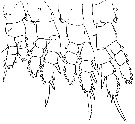 Issued from : Y. Ranga Reddy & Y. Radhakrishna in Hydrobiologia, 1982, 87. [p.259, Plate II, 12-15]. Female: 12, P1; 13, P2; 14, P3; 15, P4.
|
 Issued from : Y. Ranga Reddy & Y. Radhakrishna in Hydrobiologia, 1982, 87. [p.257]. Female: The length-width proportions of the caudal ramus and setae (counted from outside).
|
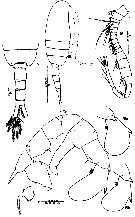 Issued from : Y. Ranga Reddy & Y. Radhakrishna in Hydrobiologia, 1982, 87. [p.259, Plate II, 16-19b]. Male: 16, habitus (lateral); 17, posterior part of prosome and urosome (dorsal); 18, Right A1; 19, P5 (anterior view); 19a & 19b, exopodite 2 of left P5. Nota: Left A1 as in the female except for the aesthetasc on segment 3 stalked and comparatively longer, extending up to 9th segment. Right A1 modified, consisting of 21 segments; geniculation lies between segments 18 and 19; segments 8-12 narrow, segments 13-17 moderately dilated; a hooked spine on the segment 10, an unarmed tooth-plate on segment 17, fine needle-like spines along the margin of segment 18, and fine, slightly curved teeth along the proximal part of segment 19, segments 20 and 21 fused and ending in a knoblike process with 5 setae and 1 aesthetasc. - Urosome of 5 segments plus caudal rami have the proportional lengths 10.5 : 20.0 : 16.0 : 18.5 : 8.0 : 22.0. 1st urosomal segment somewhat broad midway, with a minute spine on either side. - The dorso-posterior border of the 2nd, 3rd and 4th segments with a transverse row of fine spines. - Caudal rami and setae as in the female, the only difference being that the middle caudal seta quite normal ; all the setae jointed and slenderer than in female.
|
 Issued from : K.S. Santu, S. Bijoy Nandan, R.I. Cleetus & M. Harikrishnan in Mitochondrial DNA Part A, 2017. [p.6, Figs. 9, 10]. Female;: fig.9, habitus (lateral view); fig.10, urosome (lateral view). Nota: - Prosome : Urosome ratio 60 : 40. - Prosome 1.29 times longer than broad (9.5 : 1.6). - Urosome 4-segmented with caudal rami. Proportional lengths of urosomal segments plus caudal rami - 33 : 16 : 19 : 11 : 21 = 100.. - Genital segment symmetrical; provided with pair of outwardly projecting sutures and 4 transversaly arranged rows of minute spines on dorsal surface. - Caudal rami 3.14 times long as wide with hairy inner margins; each ramus bearing 5 unsegmented setae, of which muddle one dilated aznd spear-head-shaped; small sensory bristhe lying between 4th and 5th setae - A1 21-segmented, reaching to posterior margin of genital segment.
|
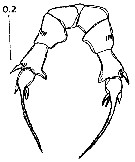 Issued from : K.S. Santu, S. Bijoy Nandan, R.I. Cleetus & M. Harikrishnan in Mitochondrial DNA Part A, 2017. [p.6, Fig. 11. Female: P5 (dorsal view). Scale bar in mm. Nota: - P5 consisting of coxa basis,, exopodal segments 1 and 2; left and right legs identical and uniramous; basis with ledge on inner margin and furnished with few spinules on distal outer region; exopodal segment 1 with strong internally serrate spine at distal external angle and short, blunt spinous process with hyaline lobe at distal internal angle; distal external margins furnished with small row of spinules just behind above mentioned serrate spine; exopodal segment 2 with 4 strong serrate spines, one of which longer than other 3 short ones
|
 Issued from : K.S. Santu, S. Bijoy Nandan, R.I. Cleetus & M. Harikrishnan in Mitochondrial DNA Part A, 2017. [p.7, Figs. 12, 13]. Male: fig.12, habitus (dorsal view); fig.13, urosome (dorsal view). Nota: - Prosome : Urosome ratio 59 : 41. - Urosome 5-segmented plus caudal rami; length proportions 16 : 18 : 18 : 18 : 10 : 20 = 100. - Caudal rami and caudal setae as in female except that middle setae normal; all setae joined and more slender than in female.
|
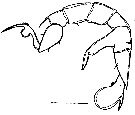 Issued from : K.S. Santu, S. Bijoy Nandan, R.I. Cleetus & M. Harikrishnan in Mitochondrial DNA Part A, 2017. [p.7, Fig.14]. Male: P5 (ventral view). Scale bar in mm. Nota: - P5 as described by Ranga Reddy & Radhakrishna (1982).
|
 Issued from : K.S. Santu, S. Bijoy Nandan, R.I. Cleetus & M. Harikrishnan in Mitochondrial DNA Part A, 2017. [p.8, Table 3]. Morphological characteristics of female specimen of P. malayalus with previous record of P. malayalus and P. binghami. (specimen from Nambur canal, Andhra Pradesh, India).
| | | | | Compl. Ref.: | | | Madhupratap & Haridas, 1986 (p.105, tab.2) | | | | NZ: | 1 | | |
|
Distribution map of Pseudodiaptomus binghami by geographical zones
|
| | | | | | | Loc: | | | India, Cochin (Vembanad estuarine system), Burhabalanga estuary, Chilka Lake, Nagarjuna University Reservoir, W Bengal (Mandarmani creek, Hooghly estuary), Rangoon Riv. (estuary), Andaman Is. | | | | N: | 12 | | | | Lg.: | | | (81) F: 1,3; (83) M: 0,86; (1005) M: 0,91; (1190) F: 0,97-1,28; M: 0,82-0,95; (1193) F: 1,09-1,18; M: 0,85-0,91; (1211) F: 1,23-1,29; M: 0,86-0,90; {F: 0,97-1,3; M: 0,82-0,95} | | | | Rem.: | Brackish, limnic, estuary.
Incomplete data.
For Sewell (1912, p.338) this species closely resembles P. lobipes Gurney (1907), but differs by tge serration of the spines on P5 and the spinulation of the 1st abdominal segment, and the caudal setae.
According to Wellershaus (1969, p.263) the subspecies P. binghami malayalus (from Cocin Backwater, S India) differs from Sewell's typical form by different aspects: The female P5 has one terminal spine less, and the proportions of the spines are different; the female caudal rami proportions are slightly different; the female abdomen bears another pattern of spinulation dorsally; Tthe thoracic segment 5 bears some spinules ventro-laterally in both sexes; the male P5 differs in having an additional projection on the long projection of the left basipod 2, and there is a long broad spine on exopod segments 2-3.
In Lobus species group (forbesi subgroup) after Walter & al. 2006, p.203.
See remarks in Pseudodiaptomus malayalus | | | Last update : 18/12/2017 | |
|
|
 Any use of this site for a publication will be mentioned with the following reference : Any use of this site for a publication will be mentioned with the following reference :
Razouls C., Desreumaux N., Kouwenberg J. and de Bovée F., 2005-2025. - Biodiversity of Marine Planktonic Copepods (morphology, geographical distribution and biological data). Sorbonne University, CNRS. Available at http://copepodes.obs-banyuls.fr/en [Accessed December 03, 2025] © copyright 2005-2025 Sorbonne University, CNRS
|
|
 |
 |














